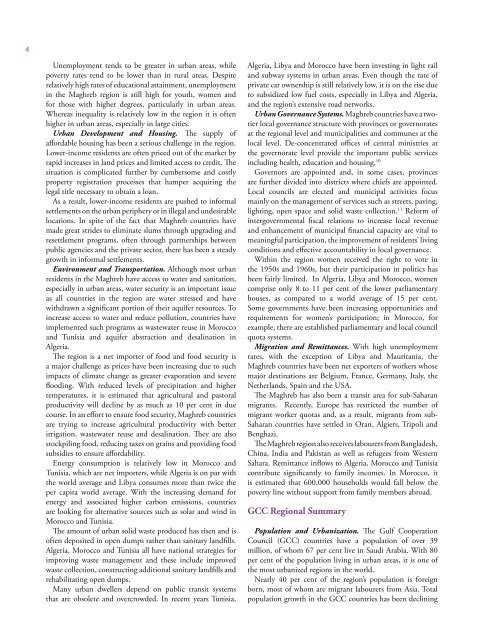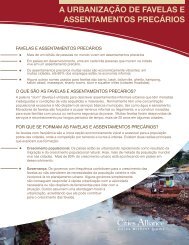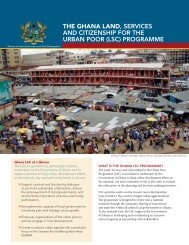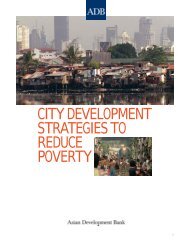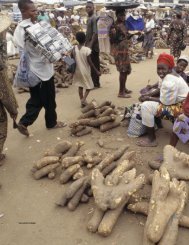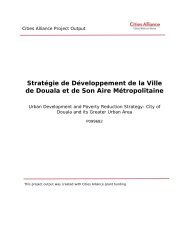Arab Cities2012 - Cities Alliance
Arab Cities2012 - Cities Alliance
Arab Cities2012 - Cities Alliance
Create successful ePaper yourself
Turn your PDF publications into a flip-book with our unique Google optimized e-Paper software.
4<br />
Unemployment tends to be greater in urban areas, while<br />
poverty rates tend to be lower than in rural areas. Despite<br />
relatively high rates of educational attainment, unemployment<br />
in the Maghreb region is still high for youth, women and<br />
for those with higher degrees, particularly in urban areas.<br />
Whereas inequality is relatively low in the region it is often<br />
higher in urban areas, especially in large cities.<br />
Urban Development and Housing. The supply of<br />
affordable housing has been a serious challenge in the region.<br />
Lower-income residents are often priced out of the market by<br />
rapid increases in land prices and limited access to credit. The<br />
situation is complicated further by cumbersome and costly<br />
property registration processes that hamper acquiring the<br />
legal title necessary to obtain a loan.<br />
As a result, lower-income residents are pushed to informal<br />
settlements on the urban periphery or in illegal and undesirable<br />
locations. In spite of the fact that Maghreb countries have<br />
made great strides to eliminate slums through upgrading and<br />
resettlement programs, often through partnerships between<br />
public agencies and the private sector, there has been a steady<br />
growth in informal settlements.<br />
Environment and Transportation. Although most urban<br />
residents in the Maghreb have access to water and sanitation,<br />
especially in urban areas, water security is an important issue<br />
as all countries in the region are water stressed and have<br />
withdrawn a significant portion of their aquifer resources. To<br />
increase access to water and reduce pollution, countries have<br />
implemented such programs as wastewater reuse in Morocco<br />
and Tunisia and aquifer abstraction and desalination in<br />
Algeria.<br />
The region is a net importer of food and food security is<br />
a major challenge as prices have been increasing due to such<br />
impacts of climate change as greater evaporation and severe<br />
flooding. With reduced levels of precipitation and higher<br />
temperatures, it is estimated that agricultural and pastoral<br />
productivity will decline by as much as 10 per cent in due<br />
course. In an effort to ensure food security, Maghreb countries<br />
are trying to increase agricultural productivity with better<br />
irrigation, wastewater reuse and desalination. They are also<br />
stockpiling food, reducing taxes on grains and providing food<br />
subsidies to ensure affordability.<br />
Energy consumption is relatively low in Morocco and<br />
Tunisia, which are net importers, while Algeria is on par with<br />
the world average and Libya consumes more than twice the<br />
per capita world average. With the increasing demand for<br />
energy and associated higher carbon emissions, countries<br />
are looking for alternative sources such as solar and wind in<br />
Morocco and Tunisia.<br />
The amount of urban solid waste produced has risen and is<br />
often deposited in open dumps rather than sanitary landfills.<br />
Algeria, Morocco and Tunisia all have national strategies for<br />
improving waste management and these include improved<br />
waste collection, constructing additional sanitary landfills and<br />
rehabilitating open dumps.<br />
Many urban dwellers depend on public transit systems<br />
that are obsolete and overcrowded. In recent years Tunisia,<br />
Algeria, Libya and Morocco have been investing in light rail<br />
and subway systems in urban areas. Even though the rate of<br />
private car ownership is still relatively low, it is on the rise due<br />
to subsidized low fuel costs, especially in Libya and Algeria,<br />
and the region’s extensive road networks.<br />
Urban Governance Systems. Maghreb countries have a twotier<br />
local governance structure with provinces or governorates<br />
at the regional level and municipalities and communes at the<br />
local level. De-concentrated offices of central ministries at<br />
the governorate level provide the important public services<br />
including health, education and housing. 10<br />
Governors are appointed and, in some cases, provinces<br />
are further divided into districts where chiefs are appointed.<br />
Local councils are elected and municipal activities focus<br />
mainly on the management of services such as streets, paving,<br />
lighting, open space and solid waste collection. 11 Reform of<br />
intergovernmental fiscal relations to increase local revenue<br />
and enhancement of municipal financial capacity are vital to<br />
meaningful participation, the improvement of residents’ living<br />
conditions and effective accountability in local governance.<br />
Within the region women received the right to vote in<br />
the 1950s and 1960s, but their participation in politics has<br />
been fairly limited. In Algeria, Libya and Morocco, women<br />
comprise only 8 to 11 per cent of the lower parliamentary<br />
houses, as compared to a world average of 15 per cent.<br />
Some governments have been increasing opportunities and<br />
requirements for women’s participation; in Morocco, for<br />
example, there are established parliamentary and local council<br />
quota systems.<br />
Migration and Remittances. With high unemployment<br />
rates, with the exception of Libya and Mauritania, the<br />
Maghreb countries have been net exporters of workers whose<br />
major destinations are Belgium, France, Germany, Italy, the<br />
Netherlands, Spain and the USA.<br />
The Maghreb has also been a transit area for sub-Saharan<br />
migrants. Recently, Europe has restricted the number of<br />
migrant worker quotas and, as a result, migrants from sub-<br />
Saharan countries have settled in Oran, Algiers, Tripoli and<br />
Benghazi.<br />
The Maghreb region also receives labourers from Bangladesh,<br />
China, India and Pakistan as well as refugees from Western<br />
Sahara. Remittance inflows to Algeria, Morocco and Tunisia<br />
contribute significantly to family incomes. In Morocco, it<br />
is estimated that 600,000 households would fall below the<br />
poverty line without support from family members abroad.<br />
GCC Regional Summary<br />
Population and Urbanization. The Gulf Cooperation<br />
Council (GCC) countries have a population of over 39<br />
million, of whom 67 per cent live in Saudi <strong>Arab</strong>ia. With 80<br />
per cent of the population living in urban areas, it is one of<br />
the most urbanized regions in the world.<br />
Nearly 40 per cent of the region’s population is foreign<br />
born, most of whom are migrant labourers from Asia. Total<br />
population growth in the GCC countries has been declining


